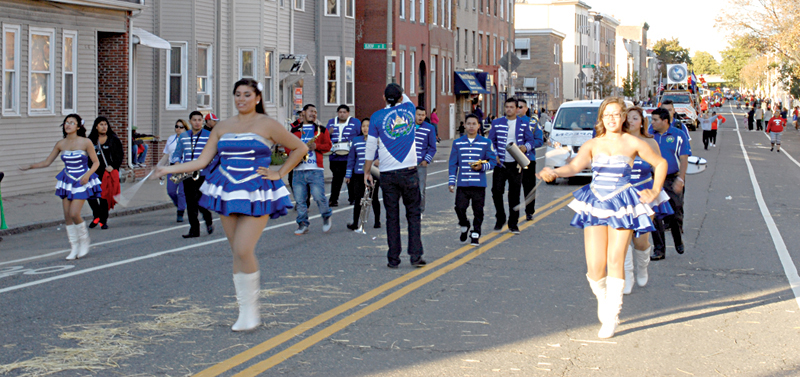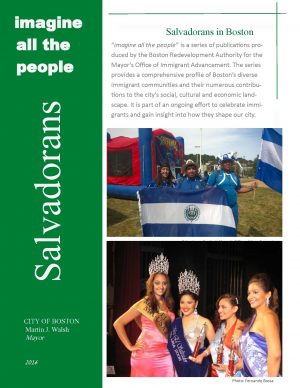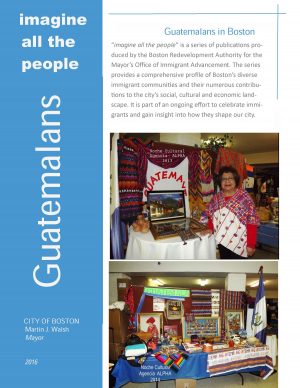Boston Banda de Paz, a Salvadoran “peace” band, marches in East Boston, 2014. Courtesy of El Planeta.
Central Americans began arriving in large numbers in the Boston area in the early 1980s when violence and civil war swept through their homelands. Following the Nicaraguan revolution in 1979, US-supported military regimes in El Salvador and Guatemala launched wars against leftist guerillas that led to mass killings and widespread human rights abuses. Tens of thousands of refugees fled the region, mainly workers and peasants, including indigenous Maya displaced from the rural highlands of Guatemala. Political tensions in nearby Honduras also propelled out- migration there, with several thousand landing in greater Boston.
Because of its ties to anti-communist regimes in the region, the US did not grant refugee status to these migrants; instead, many entered illegally hoping to apply for asylum. A local sanctuary movement provided support for Salvadoran and Guatemalan newcomers in the mid-eighties, and their communities grew—from fewer than 2000 statewide in 1980 to more than 14,000 by 1990. Some of these newcomers later won asylum following a 1991 legal settlement in American Baptist Churches v. Thornberg, while others avoided deportation by applying for Temporary Protected Status under the 1990 Immigration Act. Although official hostilities in Central America subsided in the 1990s, Central Americans have continued to arrive in Massachusetts as political repression, poverty, crime, and youth violence have fueled an ongoing exodus.
Patterns of Settlement
Declaring itself a sanctuary for unauthorized Central American migrants in 1984, the Old Baptist Cambridge Church became an early center for Salvadorans and Guatemalans seeking asylum. Many settled in the East Cambridge neighborhood known as the Port, where Puerto Rican and Dominican migrants had established a thriving Spanish-speaking community in the postwar era. In 1985, Cambridge declared itself a sanctuary city, making it a relatively safe haven where migrants could live without harassment from federal immigration authorities. Central Americans also settled in East Boston in the 1980s and 1990s, another older Puerto Rican settlement that later became a pan-Latino community.
As gentrification and the end of rent control in 1995 pushed housing costs upward in Boston and Cambridge, Salvadorans moved into the nearby suburbs of Somerville and Chelsea, while Guatemalans settled in Chelsea, Lynn, and Waltham. By contrast, Hondurans remained more concentrated in the city of Boston, mainly in Roxbury, Dorchester, and Mattapan, but they too joined the growing Central American community in Chelsea. The combined impact of Salvadoran, Guatemalan, and Honduran settlement helped make Chelsea a majority Latino city by 2010 as well as the city with the highest immigrant population in Massachusetts.
Workforce Participation
Historically, Central American migrants in Massachusetts have had high rates of employment; in the year 2000, more than 70 percent of Salvadorans and Guatemalans who were 16 or older were engaged in the labor force (compared to 66 percent of the total population). These workers were concentrated in lower-paid manufacturing and service industries, particularly food services, cleaning, and building maintenance, where the work was often part-time and without benefits. Even with multiple workers per family, Central Americans have had significantly lower median family incomes and higher poverty rates compared to the general population. Lower levels of educational achievement, both in their homelands and in greater Boston, have also contributed to the concentration of Central Americans in lower-paying occupations. Likewise, their historically high rates of unauthorized migration—combined with more restrictive federal and state laws—have limited migrants’ employment options and their children’s access to higher education. Nevertheless, Salvadoran and Central American-owned businesses have been proliferating in both East Boston and Chelsea, making them a more vital and visible part of those communities.




